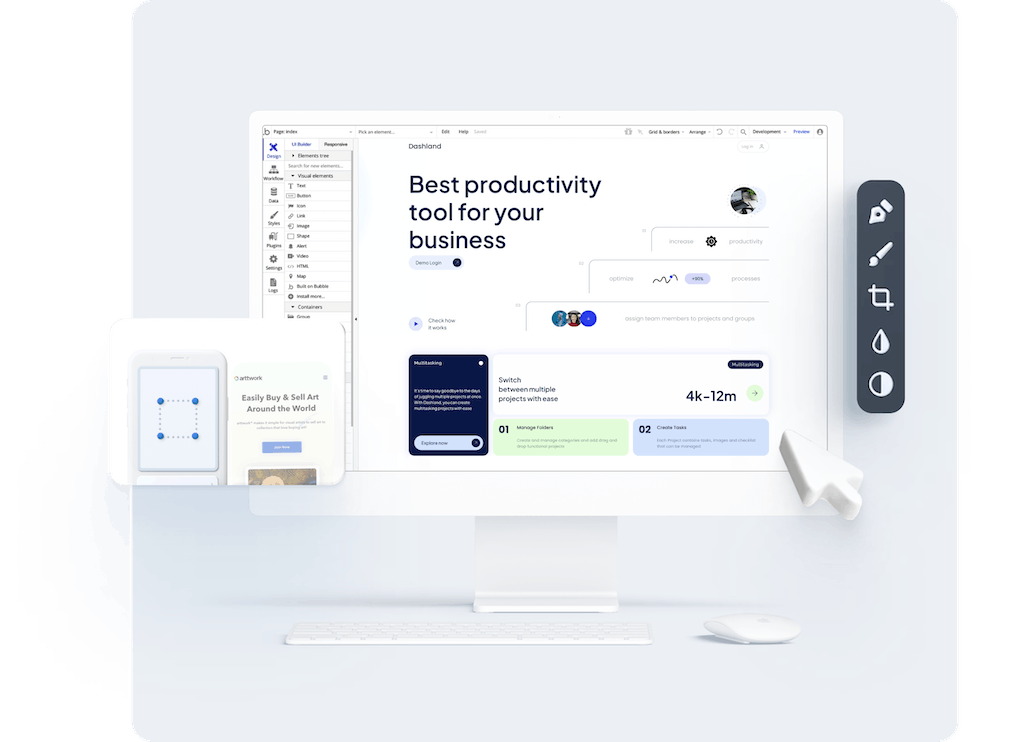In today’s fast-paced digital landscape, the demand for user-friendly and efficient web development solutions is at an all-time high. No-code platforms have emerged as a game-changer, allowing individuals and businesses alike to create powerful and functional web applications without the need for complex coding. One such platform that has been gaining significant attention is Bubble.io. In this article, we will explore the world of no-code platforms, delve into the features and benefits of Bubble.io, compare it with other popular platforms, evaluate its performance, and analyze the pricing structures of Bubble.io and its competitors.
Understanding No-Code Platforms
Before we dive into the specifics of Bubble.io, let’s first define what no-code platforms are and understand their rise in popularity. No-code platforms enable users to build websites and web applications without writing a single line of code. These platforms provide a visual interface and pre-built components that can be easily customized and connected, eliminating the need for extensive technical knowledge.
No-code platforms have revolutionized the way people approach web development. In the past, building a website or web application required a deep understanding of programming languages like HTML, CSS, and JavaScript. It was a daunting task that often required hiring professional developers or spending countless hours learning how to code. However, with the advent of no-code platforms, the barrier to entry has been significantly lowered.
Imagine having the power to create stunning and functional web applications without any coding experience. That’s exactly what no-code platforms offer. With drag-and-drop functionality and an intuitive interface, users can unleash their creativity and bring their ideas to life in a matter of hours, rather than weeks or months. Whether you’re a small business owner, a creative entrepreneur, or an aspiring developer, no-code platforms provide a level playing field for all.
Defining No-Code Platforms
No-code platforms empower individuals with little to no coding experience to create stunning and functional web applications. With drag-and-drop functionality and an intuitive interface, users can unleash their creativity and bring their ideas to life in a matter of hours, rather than weeks or months.
These platforms offer a wide range of pre-built components and templates that can be easily customized to fit specific needs. From simple landing pages to complex web applications, no-code platforms provide the tools necessary to build a professional online presence without the need for extensive technical knowledge.
Furthermore, no-code platforms often come with built-in integrations that allow users to connect their web applications with popular services and APIs. This means that you can easily incorporate features like payment processing, email marketing, and social media sharing into your web application without writing any code.
The Rise of No-Code Platforms
No-code platforms have witnessed a meteoric rise in recent years due to their ability to democratize web development. Traditionally, creating a website or web application required a substantial investment of time, money, and technical expertise. Hiring professional developers or learning how to code were the only options for many individuals and businesses.
However, no-code platforms have disrupted this paradigm, making web development accessible to anyone with a vision. Whether you’re a solopreneur, a startup founder, or a non-technical individual, you can now create a professional website or web application without breaking the bank or spending months learning how to code.
Moreover, no-code platforms have opened up new opportunities for innovation and entrepreneurship. With the ability to quickly prototype and iterate on ideas, individuals and businesses can test the market and validate their concepts without significant upfront investment. This has led to a surge in creativity and a flourishing ecosystem of no-code enthusiasts, communities, and marketplaces.
In conclusion, no-code platforms have transformed the landscape of web development, empowering individuals and businesses to create stunning and functional web applications without writing a single line of code. With their intuitive interfaces, pre-built components, and extensive integrations, these platforms have made web development accessible to all, fueling innovation and democratizing the digital world.
Introduction to Bubble.io
Bubble.io is a leading no-code platform that has gained popularity for its wide range of features and intuitive user interface. Let’s explore some of the key features that set Bubble.io apart:
Features of Bubble.io
Bubble.io offers a plethora of features that empower users to create sophisticated web applications. From database integration and user authentication to dynamic content and API connections, Bubble.io provides a comprehensive toolkit for turning ideas into reality.
One of the standout features of Bubble.io is its powerful database integration capabilities. With Bubble.io, you can easily connect your web application to a database, allowing you to store and retrieve data seamlessly. Whether you need to create a simple contact form or a complex e-commerce platform, Bubble.io’s database integration feature makes it a breeze.
In addition to its database integration, Bubble.io also offers robust user authentication functionality. With just a few clicks, you can set up user registration and login systems, ensuring that only authorized individuals can access your web application. This feature is particularly useful for creating membership-based platforms or secure internal tools.
Another impressive feature of Bubble.io is its ability to handle dynamic content. With Bubble.io’s dynamic data capabilities, you can create web applications that display real-time information, such as live chat feeds or dynamic pricing. This feature adds a layer of interactivity and personalization to your web application, enhancing the user experience.
Bubble.io also excels in its API connection capabilities. With Bubble.io, you can easily integrate your web application with external services and APIs, allowing you to leverage the power of third-party tools. Whether you need to integrate with payment gateways, social media platforms, or mapping services, Bubble.io’s API connection feature makes it seamless.
Benefits of Using Bubble.io
There are numerous benefits to choosing Bubble.io as your preferred no-code platform. Firstly, the platform’s visual interface and drag-and-drop functionality make it incredibly easy to use, even for beginners. You don’t need to have any coding experience to start building your web application with Bubble.io. Simply drag and drop elements onto the canvas, configure their properties, and watch your application come to life.
Additionally, Bubble.io offers a responsive design, ensuring that your web application will look great on any device. With the increasing use of mobile devices, it’s crucial to have a web application that adapts to different screen sizes. Bubble.io takes care of this for you, allowing you to focus on building your application without worrying about responsiveness.
Moreover, with Bubble.io’s robust community and extensive documentation, help is never far away. If you ever get stuck or have a question, you can turn to the Bubble.io community for support. The community is filled with experienced users and experts who are always willing to help. Additionally, Bubble.io provides comprehensive documentation and tutorials, making it easy to learn and master the platform.
In conclusion, Bubble.io is a powerful no-code platform that offers a wide range of features and benefits. Whether you’re a beginner looking to build your first web application or an experienced developer looking to rapidly prototype ideas, Bubble.io provides the tools and resources you need to bring your vision to life.
Comparing Bubble.io with Other No-Code Platforms
While Bubble.io offers a robust set of features, it’s essential to compare it with other no-code platforms to understand its strengths and weaknesses. Let’s explore how Bubble.io stacks up against some popular alternatives:
Bubble.io vs. Wix
Wix is renowned for its user-friendly website builder. While Wix provides an excellent option for static websites, Bubble.io shines when it comes to creating dynamic and interactive web applications. With Bubble.io’s extensive database capabilities and complex logic workflows, it surpasses Wix in terms of scalability and functionality.
When using Bubble.io, you have the flexibility to create complex web applications that can handle large amounts of data and perform intricate calculations. This makes it an ideal choice for businesses that require advanced functionality, such as real-time data updates, user authentication, and integrations with external services.
Additionally, Bubble.io offers a visual interface that allows you to design and customize your web application’s user interface without writing code. This empowers individuals with little to no coding experience to create professional-looking applications with ease.
Bubble.io vs. Shopify
Shopify is a powerful e-commerce platform that caters to online businesses. While Shopify excels in providing a seamless online shopping experience, Bubble.io goes beyond that by allowing users to build fully customized and scalable web applications.
With Bubble.io, users have greater control over the look, feel, and functionality of their web applications. You can create custom workflows, automate processes, and integrate with various third-party services to enhance the overall user experience.
Furthermore, Bubble.io offers robust database capabilities, enabling you to manage and analyze large amounts of data efficiently. This is particularly beneficial for businesses that require advanced inventory management, customer relationship management, and reporting functionalities.
Bubble.io vs. WordPress
WordPress is a popular content management system that is widely used for blogging and website creation. While WordPress offers a vast library of plugins and themes, it falls short when it comes to building complex web applications.
Bubble.io’s visual interface and extensive feature set make it a better choice for those looking to create robust and interactive web applications. With Bubble.io, you can build complex logic workflows, create dynamic user interfaces, and integrate with various APIs to extend the functionality of your application.
Moreover, Bubble.io provides a scalable infrastructure that can handle high traffic and large datasets. This makes it suitable for businesses that require applications with high performance and reliability.
Additionally, Bubble.io offers a collaborative environment where multiple team members can work together on the same project simultaneously. This enhances productivity and streamlines the development process.
In conclusion, while other no-code platforms like Wix, Shopify, and WordPress have their strengths, Bubble.io stands out for its ability to create dynamic and interactive web applications with complex functionalities. Whether you are building an e-commerce platform, a data-driven application, or a custom web solution, Bubble.io offers the flexibility, scalability, and ease of use that can take your project to the next level.
Evaluating Platform Performance
When selecting a no-code platform, it’s essential to consider performance factors such as speed and customization capabilities. Let’s explore how Bubble.io fares in these areas:
Speed and Efficiency
Bubble.io delivers impressive speed and efficiency, allowing users to build and deploy web applications without any coding delays. The platform’s cloud infrastructure ensures optimal performance, ensuring that your web application loads quickly and responds seamlessly to user interactions.
Customization Capabilities
Customizability is a crucial aspect of any web development platform. Bubble.io allows users to tailor their web applications to their exact specifications. With a wide range of design tools, data-driven workflows, and dynamic content capabilities, Bubble.io provides ample room for creativity and customization.
Pricing: Bubble.io and Competitors
When considering a no-code platform, pricing structures play a vital role in decision-making. Let’s explore the pricing structures of Bubble.io and some of its key competitors:
Bubble.io Pricing Structure
Bubble.io offers several pricing plans to cater to different needs. From the Hobby plan, which is perfect for individuals and small projects, to the Professional and Production plans, designed for businesses and high-traffic applications, Bubble.io provides flexibility and scalability to meet various requirements.
Competitor Pricing Structures
While Bubble.io offers competitive pricing, it’s essential to consider the pricing structures of other no-code platforms. Wix and WordPress both offer free plans with limited features, while their premium plans vary in terms of price and functionality. Shopify follows a subscription-based pricing model, with different plans catering to businesses of different sizes.
As the demand for no-code platforms continues to soar, Bubble.io has positioned itself as a front-runner in the industry. With its extensive feature set, intuitive interface, and impressive performance, Bubble.io empowers users to create stunning web applications without the need for coding. When considering a no-code platform, it’s crucial to evaluate the specific requirements of your project and compare the offerings of different platforms to ensure the best fit. Whether you are an aspiring entrepreneur or an established business, Bubble.io provides a powerful toolset to unleash your creativity and transform your ideas into reality.




